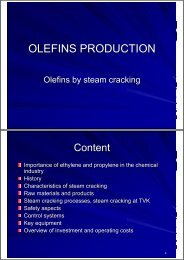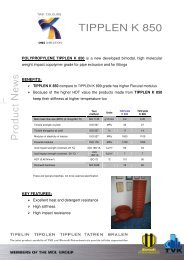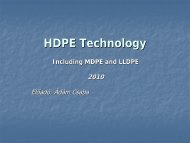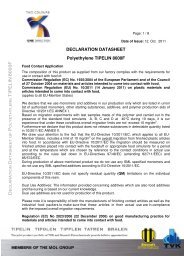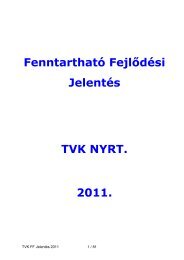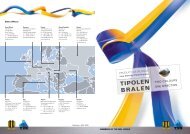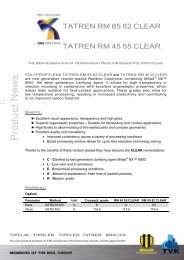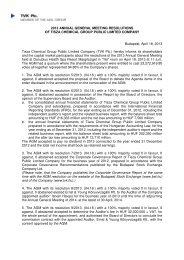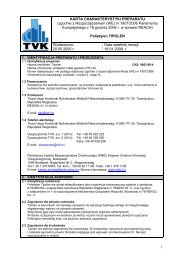LDPE Technology - TVK
LDPE Technology - TVK
LDPE Technology - TVK
You also want an ePaper? Increase the reach of your titles
YUMPU automatically turns print PDFs into web optimized ePapers that Google loves.
<strong>LDPE</strong> <strong>Technology</strong><br />
Előad<br />
adó: : Csernyik István<br />
2010
Content<br />
• What is <strong>LDPE</strong><br />
• Application<br />
• History<br />
• Process theory<br />
• Autoclave process<br />
• Tubular process<br />
• Process steps<br />
• Process control<br />
• Process safety<br />
• Key equipment<br />
• Investment cost<br />
• Cost of production<br />
2
What is <strong>LDPE</strong><br />
• Low<br />
Density<br />
PolyEthylene<br />
• Typical properties<br />
• Density 0,915-0,93<br />
0,935<br />
• Melt index 0,3->20 g/10 min (190 C/2,16<br />
kg)<br />
• Melting point<br />
• Polydispersity 5,5<br />
grades)<br />
120 C<br />
5,5 – 6 (<strong>TVK</strong> tubular<br />
3
Application<br />
Extrusion<br />
coating<br />
10%<br />
Other<br />
14%<br />
Injection<br />
moulding<br />
7%<br />
Blow<br />
moulding<br />
4%<br />
Film<br />
65%<br />
4
Application by Properties<br />
100<br />
MI, g/10 min/190 C<br />
10<br />
1<br />
INJECTION MOULDING<br />
EXTRUSION COATING<br />
FILM EXTRUSION<br />
BLOW MOULDING<br />
0,1<br />
0,915 0,92 0,925 0,93 0,935<br />
Density, kg/dm 3<br />
5
History<br />
• <strong>LDPE</strong> was discovered by ICI in 1933 → autoclave<br />
process in 1938<br />
• BASF developed the first tubular process during WW II<br />
• High variation of autoclave and tubular processes by<br />
different licensors<br />
• Nowadays licences available up to 400 kt/y plant<br />
capacity<br />
• Global consumption in 2009: 18 million t<br />
• <strong>TVK</strong> <strong>LDPE</strong> plants<br />
• 1970 - ICI autoclave process 24 kt/y – debottlenecked to 50 kt/y<br />
• 1991 - BASF tubular process 60 kt/y<br />
6
Process Theory 1<br />
• Free radical reaction<br />
• Initiation<br />
I → R· + R· R<br />
Initiators: typically organic peroxides<br />
• Propagation<br />
R· + CH 2<br />
CH 2<br />
→ RCH 2<br />
CH 2·<br />
R(CH 2<br />
CH 2<br />
) n-1<br />
CH 2<br />
CH 2· + CH 2<br />
CH 2<br />
→ R(CH 2<br />
CH 2<br />
) n<br />
CH 2<br />
CH 2·<br />
• Termination<br />
• Combination<br />
R x· + R y·→ P x+y<br />
• Disproportioning<br />
ing<br />
R x· + R y·→ P x<br />
+ P y<br />
7
Process Theory 2<br />
• Other reactions<br />
• Chain transfer – important to control<br />
molecular weight<br />
R x· + CH 2 CH 2 →P x + R 1· by monomer<br />
R x· + M→P x + M· M<br />
by modifier<br />
• Cracking – results in shorter chains<br />
R x·→P y + R x-y·<br />
8
Process Theory 3<br />
Branching – <strong>LDPE</strong> characterised by high degree<br />
of short and long chain branching<br />
• Short chain branching – responsible for density<br />
Intramolecular chain transfer and copolymerisation result in<br />
short chain branches<br />
H<br />
C<br />
C<br />
C<br />
C<br />
C<br />
• Long chain branching<br />
Intermolecular chain transfers give long chain branches<br />
C C C C<br />
C C C<br />
H<br />
C C C<br />
C C C<br />
9
<strong>LDPE</strong> - Autoclave Process<br />
Primary<br />
compressor<br />
Secondary<br />
compressor<br />
1400 bar<br />
Autoclave<br />
reactor<br />
170 C<br />
Ethylene<br />
250 bar<br />
240 C<br />
Initiators<br />
(Peroxides)<br />
Wax<br />
separator<br />
280 C<br />
Oil<br />
separator<br />
280 bar<br />
250 C<br />
HP separator<br />
LP separator<br />
0,5 bar<br />
250 C<br />
Degassing<br />
Extruder<br />
Bagging<br />
Bulk loading<br />
10
Autoclave Reactor<br />
Total 725 l<br />
ethylene<br />
Autoclave reactor MK 10<br />
L = 4750 mm d = 18”<br />
Top Zone<br />
2 nd Zone<br />
3 rd Zone<br />
4 th Zone<br />
peroxides<br />
Thermocouple 1<br />
(1st T control)<br />
Thermocouple 2<br />
Thermocouple 3<br />
Thermocouple 4<br />
(2nd T control)<br />
Thermocouple 5<br />
Thermocouple 6<br />
Thermocouple 7<br />
(control 2nd zone T)<br />
Thermocouple 8<br />
Thermocouple 9<br />
(control 3rd zone T)<br />
Thermocouple 10<br />
(control 4th zone T)<br />
11
<strong>LDPE</strong> - Tubular Process<br />
Primary<br />
Compressor<br />
Initiator<br />
(Oxygen)<br />
Secondary<br />
Compressor<br />
LP Recycle<br />
HP Recycle<br />
Preheater<br />
Reaction<br />
Zone I<br />
250 bar<br />
2400-2900 bar<br />
HP Separator<br />
Purge<br />
180-310 C<br />
280 bar<br />
250 C<br />
LP Separator<br />
Fresh Ethylene<br />
Modifier<br />
Precooler<br />
Reaction<br />
Zone II<br />
0,5 bar<br />
250 C<br />
Degassing<br />
Bagging<br />
Bulk loading<br />
Extruder<br />
12
Autoclave vs. Tubular Process<br />
Autoclave<br />
• Conversion up to 21% -<br />
adiabatic, reaction heat<br />
removed by reactant only<br />
• 1300-2000 bar operating<br />
pressure<br />
• Higher capacity of hyper<br />
compressor<br />
• Organic peroxide initiators only<br />
• Specialty polymer capability –<br />
EVA copolymers over 40%<br />
vinyl acetate<br />
• Lower reactor capacity – 150<br />
kt/y<br />
Tubular<br />
• Conversion up to 36% -<br />
reaction<br />
heat partly removed<br />
by coolant<br />
• 2500-3200 bar operating<br />
pressure<br />
• Lower capacity of hyper but<br />
higher load<br />
• Cheaper oxygen initiator<br />
possible<br />
• Film grades with higher clarity,<br />
EVA up to 10% vinyl acetate<br />
• Reactor capacity up to 400<br />
kt/y<br />
13
Process Steps 1<br />
• Compression<br />
• Increase make up ethylene<br />
pressure to reaction<br />
pressure<br />
• Recycle unreacted ethylene<br />
• Inject modifier and<br />
comonomer<br />
• Reaction<br />
• Injection of initiators<br />
• Control temperatures for<br />
required product properties<br />
• One phase reaction – two<br />
phase only at lower<br />
pressure and temperature<br />
• Short residence time –<br />
some minutes<br />
14
Process Steps 2<br />
• HP separator<br />
• Separate melt <strong>LDPE</strong> and<br />
unreacted ethylene<br />
• LP separator<br />
• Remove unreacted ethylene<br />
• Feed tank for extruder<br />
• HP recycle<br />
• Remove low molecular weight<br />
polymer (wax)<br />
• Cool down recycle ethylene<br />
• LP recycle<br />
• Remove low molecular weight<br />
polymer (wax, oils)<br />
• Cool down recycle ethylene<br />
15
Process Steps 3<br />
• Extrusion<br />
• Homogenization<br />
• Additive dosing<br />
• Pelletizing<br />
• Degassing<br />
• Remove residual<br />
ethylene (generally<br />
less than 1000 ppm)<br />
from <strong>LDPE</strong> – to avoid<br />
explosive gas mixtures<br />
16
Process Control<br />
• Melt index (Molecular weight)<br />
• P↑ MI↓ (M w ↑)<br />
• T↑ MI↑ (M w ↓)<br />
• [Modifier]↑<br />
MI↑ (M w ↓)<br />
• Density<br />
• P↑<br />
• T↑<br />
D↑<br />
D↓<br />
• Pressure range: 1300-3000 3000 bar<br />
• Temperature range: 160-310 C<br />
17
Process Safety<br />
• Risk of decomposition<br />
• Decomposition: ethylene or polyethylene decomps to C and H 2<br />
• High temperature, high pressure, contaminations favour<br />
decomposition<br />
• Reactor and HP separator in confined area – generally<br />
behind concrete wall<br />
• Interlock system to<br />
• avoid decomposition and<br />
• protect equipment<br />
• Special metal gaskets at high pressures<br />
• Gas detectors<br />
• Fire fighting system<br />
18
Key Equipment<br />
• Compressors<br />
• Primary compressor (Booster+Primary(<br />
Booster+Primary)<br />
• 5 stages<br />
• 0,1 bar suction; 250 bar discharge<br />
• Secondary compressor (Hyper)<br />
• Two stages<br />
• 250 bar suction; 3000 bar discharge<br />
• Extruder<br />
• Hot melt extruder for homogenization<br />
19
Hyper Compressor Arrangement<br />
20
Hyper Compressor Cylinder<br />
21
Extruder Arrangement<br />
22
Single-screw<br />
Extruder<br />
23
Investment cost<br />
Basis: USGC 2008Q1<br />
Process Autoclave Autoclave Tubular<br />
Plant size 135 kt 3x135 kt 400 kt<br />
million USD<br />
ISBL 91,7 231,6 130,1<br />
OSBL 60,6 142,3 118,4<br />
Other project cost 61,2 160,5 125,1<br />
Total investment 213,5 534,4 373,6<br />
Specific investment,<br />
USD/t 1581 1320 934<br />
24
Cost of Production<br />
Basis: USGC 2008Q1<br />
Autoclave Autoclave Tubular<br />
135 kt 3x135 kt 400 kt<br />
USD/t<br />
Ethylene 1354 1354 1347<br />
Catalysts&chemicals 8 8 5<br />
Additives 14 14 14<br />
Total raw materials 1376 1376 1366<br />
Power 51 51 58<br />
Other utilities 9 9 7<br />
Steam credit -34<br />
Total utilities 60 60 31<br />
Direct cash cost 34 22 14<br />
Allocated cash cost 37 27 18<br />
Total fixed costs 71 49 32<br />
Total cash cost 1507 1485 1429<br />
100%<br />
95%<br />
90%<br />
85%<br />
80%<br />
Total fixed costs<br />
Total utilities<br />
Total raw materials<br />
135 kt 3x135 kt 400 kt<br />
Autoclave Autoclave Tubular<br />
25
Appendix: Metal Gasket<br />
26
Appendix: Hyper compressor cylinder<br />
27
Appendix: Blown Film Extrusion<br />
28
Appendix: Extrusion Coating<br />
29



